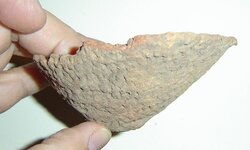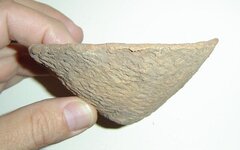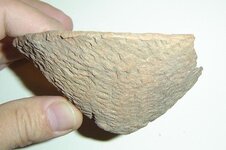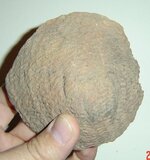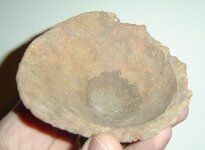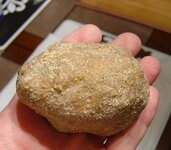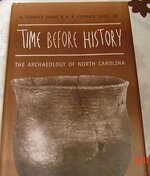Navigation
Install the app
How to install the app on iOS
Follow along with the video below to see how to install our site as a web app on your home screen.
Note: This feature may not be available in some browsers.
More options
You are using an out of date browser. It may not display this or other websites correctly.
You should upgrade or use an alternative browser.
You should upgrade or use an alternative browser.
Flea Market Find
- Thread starter Road Dog
- Start date
GatorBoy
Gold Member
- May 28, 2012
- 14,716
- 6,156
- Primary Interest:
- All Treasure Hunting
Harry Pristis said:Alright! I would call that documentation! Excellent stuff, Griswold.
I want to share that account of Cherokee potting with a friend who is a potter. Thanks!
Notice How it even mentions The sticks I was trying to tell you about. Yet you tried to make it sound absurd. Your welcome.
Amazon Forum Fav 👍
birdpointgriswold
Hero Member
Harry Pristis said:Alright! I would call that documentation! Excellent stuff, Griswold.
I want to share that account of Cherokee potting with a friend who is a potter. Thanks!
Your welcome
NC field hunter
Silver Member
- Jul 29, 2012
- 4,227
- 1,626
birdpointgriswold said:Your welcome
Looking great JG.
Road Dog
Hero Member
- Thread starter
- #45
I'm thinking this is a Badin Fabric impressed bowl. The temper applied is crushed quartz. Here is a pic of a Clay cooking ball I found on a site I hunt in Johnston Co. NC. It is tempered with quartz as well. Site I hunted was full of them. They were heated and placed in pots for cooking veggies and whatever. Also a pic of a book I have that is a good read.
Attachments
S
stefen
Guest
Actually has the appearance of a coil pot possibly formed within a gunny sack or other heavy textured fabric to maintain its pot-like shape.
As to date, it should be authenicated by age dating technology or by already known and dated remnants. This would avoid guessing dates or giving it a fabricated history. In fact, it could have been made in the last century using local clay or off-the-shelf clay compounds.
Might want to check with a local university or museum to verify if aborginy clay vessels dated prior to 1000 - 1200 AD... Texas was sparsly populated by Native Americans till around that time.
As to date, it should be authenicated by age dating technology or by already known and dated remnants. This would avoid guessing dates or giving it a fabricated history. In fact, it could have been made in the last century using local clay or off-the-shelf clay compounds.
Might want to check with a local university or museum to verify if aborginy clay vessels dated prior to 1000 - 1200 AD... Texas was sparsly populated by Native Americans till around that time.
Road Dog
Hero Member
- Thread starter
- #48
That's right GatorBoy. I thought about taking it to the Museum to get there thoughts. The Indian population in the Woodland times was kinda sparse. Maybe the area was not so hospitabe during that time.
The clay cooking balls are thought to have been in use 1000 years before the Clay Pots.
The clay cooking balls are thought to have been in use 1000 years before the Clay Pots.
NC field hunter
Silver Member
- Jul 29, 2012
- 4,227
- 1,626
Road Dog said:That's right GatorBoy. I thought about taking it to the Museum to get there thoughts. The Indian population in the Woodland times was kinda sparse. Maybe the area was not so hospitabe during that time.
The clay cooking balls are thought to have been in use 1000 years before the Clay Pots.
Every book that I have states that NC'a archaic period lasted at least 1,000 years longer than other states. I really do not understand that. At present, it's 2012. My small town is 20 years behind, say, LA. But, be you in LA or my small town, it's still 2012. See what I'm saying? I do know one thing. Pottery, and woodland artifacts in general are a rarity in the part of NC that I live in.
GatorBoy
Gold Member
- May 28, 2012
- 14,716
- 6,156
- Primary Interest:
- All Treasure Hunting
NC. That could have to do with the pH of the soil, the conditions and history of the sites in your area.. like if you're talking about a field that's been tilled and plowed for generations ect.. some land just isn't conducive to Pottery surviving very well.
Road Dog
Hero Member
- Thread starter
- #54
Every book that I have states that NC'a archaic period lasted at least 1,000 years longer than other states. I really do not understand that. At present, it's 2012. My small town is 20 years behind, say, LA. But, be you in LA or my small town, it's still 2012. See what I'm saying? I do know one thing. Pottery, and woodland artifacts in general are a rarity in the part of NC that I live in.
Maybe a sparser population changed slower due to the lack of outside influences?
GatorBoy
Gold Member
- May 28, 2012
- 14,716
- 6,156
- Primary Interest:
- All Treasure Hunting
Road Dog said:Me Too.
We're not alone... the Clovis artifact distribution tells a pretty convincing story.
NC field hunter
Silver Member
- Jul 29, 2012
- 4,227
- 1,626
GatorBoy said:NC. That could have to do with the pH of the soil, the conditions and history of the sites in your area.. like if you're talking about a field that's been tilled and plowed for generations ect.. some land just isn't conducive to Pottery surviving very well.
As I have mentioned, our land is more acidic than any of the other states. With a Ph matched only in Africa, which relates to the land bridge indirectly. However, pottery isn't even found in our waters in great abundance. Some, but not plentiful by any means. I'm sure the water has high acid content, just as the land that it runs through. To my understanding, any pottery that is, in fact found here was traded in. That provides us with knowledge of outsider presence. Could be that our location was not as drastically affected by the changing weather. We are known for having all 4 seasons, as each is meant to be. ( snow in winter, hot in summer, you get the point) if that were in fact the case, I suppose no drastic change in life would be necessary.

NC field hunter
Silver Member
- Jul 29, 2012
- 4,227
- 1,626
GatorBoy said:There has been a lot of pottery found in North Carolina. Made from indigenous material.
I was a bit misleading in my last post. I was talking about the piedmont or triad part of NC. Don't get me wrong, a shard or so will pop up every once in a blue moon in my area. It just isn't here, like it is at other locations. That isn't saying its never been here. I can drive 20 min. North and find pottery. However, it's always on a river. You know what that means. Traded in traveling.
GatorBoy
Gold Member
- May 28, 2012
- 14,716
- 6,156
- Primary Interest:
- All Treasure Hunting
It also usually means higher population density. and village sites. if you think about it people weren't really going to being bringing pottery with them to smaller hunting camps. The villages were almost always associated with the water. that's why you will find more pottery there.
Last edited:
Top Member Reactions
-
 3663
3663 -
 1992
1992 -
 1881
1881 -
 1488
1488 -
 1248
1248 -
 1092
1092 -
 1078
1078 -
 985
985 -
 856
856 -
 727
727 -
 659
659 -
 574
574 -
 476
476 -
 472
472 -
 440
440 -
E
429
-
 399
399 -
 397
397 -
 390
390 -
 381
381
Users who are viewing this thread
Total: 2 (members: 0, guests: 2)


